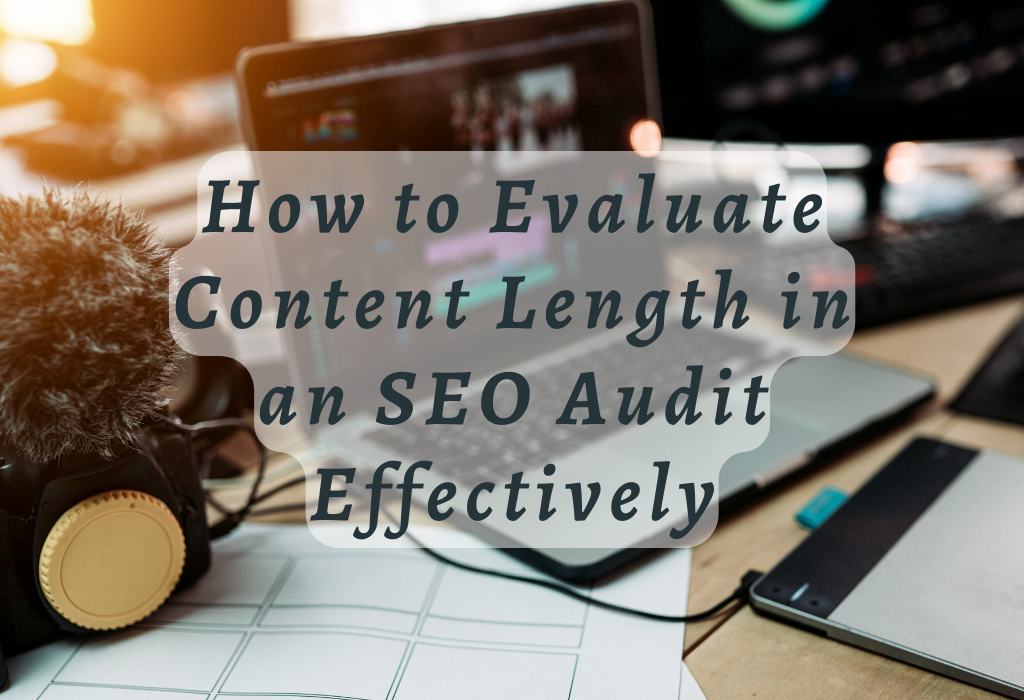Understanding how to evaluate content length in an SEO audit is crucial to optimizing your website for search engines. Content length can significantly impact your site’s rankings, and mastering the art of evaluating it will help you make informed decisions about your content strategy.
In this comprehensive guide, we’ll delve into various aspects of content length evaluation during an SEO audit. We’ll discuss identifying thin content pages that could potentially lead to penalties and performing competitor analysis for effective assessment.
Furthermore, we’ll explore tools and techniques that aid in accurately evaluating content length, ensuring optimization of metadata and handling redirects. Lastly, we’ll examine the impact longer-form articles have on search engine results page (SERP) positions and address strategies for improving low-quality main-content pages.

Evaluating Content-Length in SEO Audits
An essential aspect of an SEO audit is evaluating content length, which is significant in search engine rankings. Most audits identify thin content to avoid penalties from search engines like Google. More, to assess content length effectively, you can perform competitor analysis by comparing word counts across similar websites within your niche.
Identify Thin Content and Avoid Penalties
In the SEO world, thin content refers to pages with little or no added user value. These pages often have low-quality information or duplicate material that doesn’t provide any unique insights. Search engines like Google penalize websites with thin content because they want to ensure their users find relevant and valuable information when searching online.
To avoid penalties, it’s crucial to thoroughly evaluate your website’s existing content during an SEO audit. Look for pages with insufficient information and short content.
Perform Competitor Analysis for Effective Assessment
A comprehensive competitor analysis allows you to gauge how well your site measures up against others regarding the quality and quantity of published material. By analyzing competitors’ sites within your industry or niche, you’ll gain insight into what works best regarding optimal word count ranges for different types of articles.
Here’s the action plan:
- Gather a list: Start by compiling a list of direct competitors who share the same target audience as yours.
- Analyze their top-performing articles: Identify which pieces on each competitor’s site perform well organically (e.g., high traffic volume) using tools such as Ahrefs’ Site Explorer or SEMrush.
- Compare word counts: Determine the average length of long-form content for these top-performing articles and compare it to your site’s content length. This will provide a basis for improving your website’s content.
By conducting a thorough competitor analysis, you’ll be better equipped to create engaging, informative, and original content that meets search engine standards while catering to your target audience’s needs. Remember, quality content is key to improving your search rankings and SEO strategy.
Tools and Techniques for Content-Length Evaluation
In an SEO audit, it’s crucial to utilize the right tools and techniques to evaluate content length accurately. As recommended by John Mueller, using at least three tools can help you ensure a comprehensive assessment of your website’s performance. In this section, we’ll discuss some popular tools that can assist in evaluating content length effectively.
Utilizing Recommended Tools for Accurate Evaluation
Ensure Optimization of Metadata and Handle Redirects
Besides evaluating content length, optimizing metadata and handling redirects properly during an SEO audit is essential.
Here are some best practices:
The Impact of Longer-form Articles on Rankings
As a business owner or marketer, knowing the potential benefits of longer-form articles to your website’s search engine rankings is important. Over the past six years, several studies have shown that these types of content rank higher in search results than shorter pieces. In this section, we’ll explore why longer-form articles benefit SERP positions and how you can address low-quality main-content pages.
Benefits of Longer-Form Articles on SERP Positions
A study conducted by SERPIQ found that there is a strong correlation between content length and search engine ranking position. This means that websites with more in-depth and comprehensive content are likely to rank higher than those with short, superficial articles.
Address Low-Quality Main-Content Pages
To improve your website’s overall performance and avoid penalties from search engines like Google, it is crucial to identify and address low-quality main content (MC) pages. These pages typically feature small amounts of MC accompanied by high bounce rates, which negatively impact your site’s search engine rankings.
Here are some steps you can take to improve low-quality main-content pages:
- Analyze user behaviour: Use tools like Google Analytics to identify the pages with high bounce rates and low time on the page. This will help you pinpoint problematic content that needs improvement.
- Audit existing content: Perform a thorough review of the identified low-quality MC pages and assess whether they provide value for users or not. If deemed useless, consider changing them to be more informative or deleting them entirely if not relevant to the website’s purpose.
- Create comprehensive articles: Focus on creating longer-form articles that cover topics extensively and offer valuable insights for readers. Construct organized, legible and captivating posts to encourage users to spend more time with the material.
FAQs in Relation to How to Evaluate Content-Length in an Seo Audit
Conclusion
When it comes to SEO audits, evaluating content length is crucial for identifying thin or low-quality pages that could be hurting your search rankings. By utilizing recommended tools and techniques, businesses can accurately assess the impact of longer-form articles on SERP positions and optimize metadata to avoid penalties.
Incorporating more extended pieces of content into your SEO plan can produce meaningful benefits for search engine results. However, it’s important to address any low-quality main-content pages that may be dragging down overall performance.
If you’re looking to improve your website’s SEO performance through effective content evaluation, OptiLocal offers comprehensive solutions tailored to the unique needs of businesses, entrepreneurs, SMBs, and eCommerce websites. For more details on how Mindflowmarketing can help improve your website’s SEO performance, please reach out to us now!